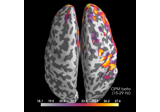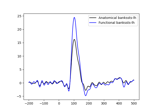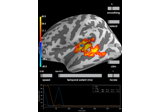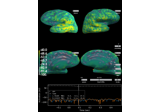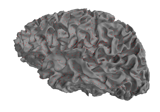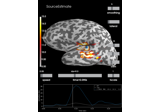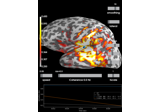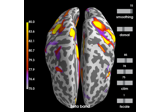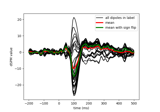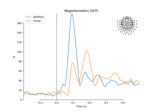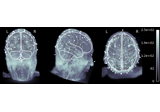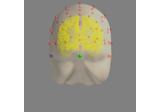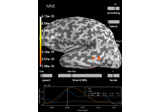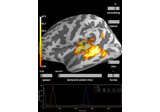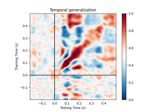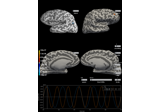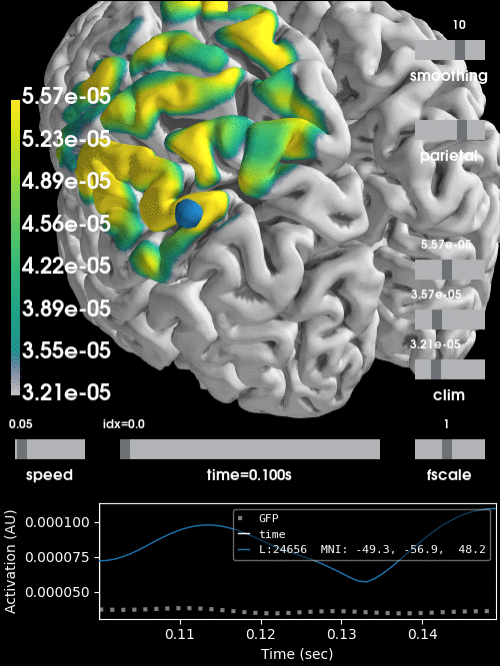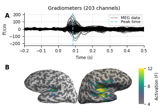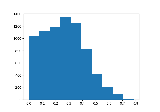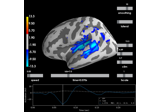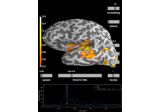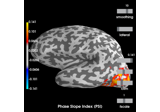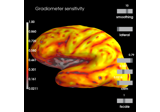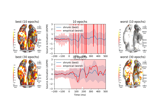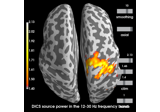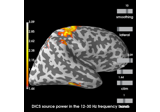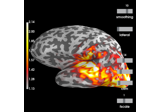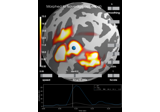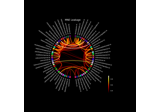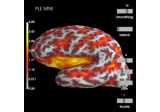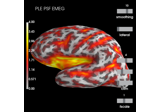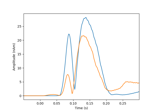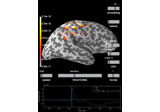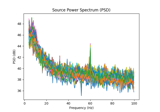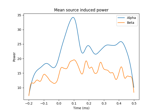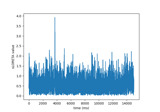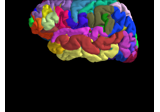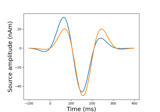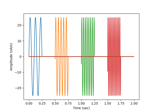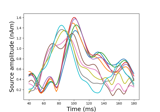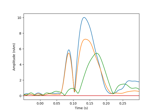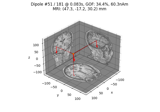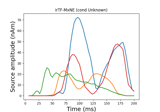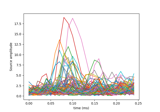mne.SourceEstimate¶
-
class
mne.SourceEstimate(data, vertices, tmin, tstep, subject=None, verbose=None)[source]¶ Container for surface source estimates.
- Parameters
- data
arrayof shape (n_dipoles, n_times) |tuple, shape (2,) The data in source space. When it is a single array, the left hemisphere is stored in data[:len(vertices[0])] and the right hemisphere is stored in data[-len(vertices[1]):]. When data is a tuple, it contains two arrays:
“kernel” shape (n_vertices, n_sensors) and
“sens_data” shape (n_sensors, n_times).
In this case, the source space data corresponds to
np.dot(kernel, sens_data).- vertices
listofarray, shape (2,) Vertex numbers corresponding to the data. The first element of the list contains vertices of left hemisphere and the second element contains vertices of right hemisphere.
- tminscalar
Time point of the first sample in data.
- tstepscalar
Time step between successive samples in data.
- subject
str|None The subject name. While not necessary, it is safer to set the subject parameter to avoid analysis errors.
- verbosebool,
str,int, orNone If not None, override default verbose level (see
mne.verbose()and Logging documentation for more). If used, it should be passed as a keyword-argument only.
- data
See also
VectorSourceEstimateA container for vector source estimates.
VolSourceEstimateA container for volume source estimates.
MixedSourceEstimateA container for mixed surface + volume source estimates.
- Attributes
Methods
__add__(a)Add source estimates.
__div__(a)Divide source estimates.
__hash__(/)Return hash(self).
__mul__(a)Multiply source estimates.
__neg__()Negate the source estimate.
__sub__(a)Subtract source estimates.
apply_baseline([baseline, verbose])Baseline correct source estimate data.
bin(width[, tstart, tstop, func])Return a source estimate object with data summarized over time bins.
center_of_mass([subject, hemi, …])Compute the center of mass of activity.
copy()Return copy of source estimate instance.
crop([tmin, tmax, include_tmax])Restrict SourceEstimate to a time interval.
estimate_snr(info, fwd, cov[, verbose])Compute time-varying SNR in the source space.
expand(vertices)Expand SourceEstimate to include more vertices.
extract_label_time_course(labels, src[, …])Extract label time courses for lists of labels.
get_peak([hemi, tmin, tmax, mode, …])Get location and latency of peak amplitude.
in_label(label)Get a source estimate object restricted to a label.
mean()Make a summary stc file with mean over time points.
plot([subject, surface, hemi, colormap, …])Plot SourceEstimate.
resample(sfreq[, npad, window, n_jobs, verbose])Resample data.
save(fname[, ftype, verbose])Save the source estimates to a file.
sqrt()Take the square root.
sum()Make a summary stc file with sum over time points.
time_as_index(times[, use_rounding])Convert time to indices.
to_data_frame([index, scalings, …])Export data in tabular structure as a pandas DataFrame.
to_original_src(src_orig[, subject_orig, …])Get a source estimate from morphed source to the original subject.
transform(func[, idx, tmin, tmax, copy])Apply linear transform.
transform_data(func[, idx, tmin_idx, tmax_idx])Get data after a linear (time) transform has been applied.
-
apply_baseline(baseline=(None, 0), *, verbose=None)[source]¶ Baseline correct source estimate data.
- Parameters
- baseline
None|tupleof length 2 The time interval to consider as “baseline” when applying baseline correction. If
None, do not apply baseline correction. If a tuple(a, b), the interval is betweenaandb(in seconds), including the endpoints. IfaisNone, the beginning of the data is used; and ifbisNone, it is set to the end of the interval. If(None, None), the entire time interval is used.Note
The baseline
(a, b)includes both endpoints, i.e. all timepointstsuch thata <= t <= b.Correction is applied to each source individually in the following way:
Calculate the mean signal of the baseline period.
Subtract this mean from the entire source estimate data.
Note
Baseline correction is appropriate when signal and noise are approximately additive, and the noise level can be estimated from the baseline interval. This can be the case for non-normalized source activities (e.g. signed and unsigned MNE), but it is not the case for normalized estimates (e.g. signal-to-noise ratios, dSPM, sLORETA).
Defaults to
(None, 0), i.e. beginning of the the data until time point zero.- verbosebool,
str,int, orNone If not None, override default verbose level (see
mne.verbose()and Logging documentation for more). If used, it should be passed as a keyword-argument only. Defaults to self.verbose.
- baseline
- Returns
- stcinstance of
SourceEstimate The baseline-corrected source estimate object.
- stcinstance of
Notes
Baseline correction can be done multiple times.
-
bin(width, tstart=None, tstop=None, func=<function mean>)[source]¶ Return a source estimate object with data summarized over time bins.
Time bins of
widthseconds. This method is intended for visualization only. No filter is applied to the data before binning, making the method inappropriate as a tool for downsampling data.- Parameters
- widthscalar
Width of the individual bins in seconds.
- tstartscalar |
None Time point where the first bin starts. The default is the first time point of the stc.
- tstopscalar |
None Last possible time point contained in a bin (if the last bin would be shorter than width it is dropped). The default is the last time point of the stc.
- func
callable() Function that is applied to summarize the data. Needs to accept a numpy.array as first input and an
axiskeyword argument.
- Returns
- stc
SourceEstimate|VectorSourceEstimate The binned source estimate.
- stc
-
center_of_mass(subject=None, hemi=None, restrict_vertices=False, subjects_dir=None, surf='sphere')[source]¶ Compute the center of mass of activity.
This function computes the spatial center of mass on the surface as well as the temporal center of mass as in [1].
Note
All activity must occur in a single hemisphere, otherwise an error is raised. The “mass” of each point in space for computing the spatial center of mass is computed by summing across time, and vice-versa for each point in time in computing the temporal center of mass. This is useful for quantifying spatio-temporal cluster locations, especially when combined with
mne.vertex_to_mni().- Parameters
- subject
str|None The subject the stc is defined for.
- hemi
int, orNone Calculate the center of mass for the left (0) or right (1) hemisphere. If None, one of the hemispheres must be all zeroes, and the center of mass will be calculated for the other hemisphere (useful for getting COM for clusters).
- restrict_verticesbool |
arrayofint| instance ofSourceSpaces If True, returned vertex will be one from stc. Otherwise, it could be any vertex from surf. If an array of int, the returned vertex will come from that array. If instance of SourceSpaces (as of 0.13), the returned vertex will be from the given source space. For most accuruate estimates, do not restrict vertices.
- subjects_dir
str|None The path to the FreeSurfer subjects reconstructions. It corresponds to FreeSurfer environment variable
SUBJECTS_DIR.- surf
str The surface to use for Euclidean distance center of mass finding. The default here is “sphere”, which finds the center of mass on the spherical surface to help avoid potential issues with cortical folding.
- subject
- Returns
- vertex
int Vertex of the spatial center of mass for the inferred hemisphere, with each vertex weighted by the sum of the stc across time. For a boolean stc, then, this would be weighted purely by the duration each vertex was active.
- hemi
int Hemisphere the vertex was taken from.
- t
float Time of the temporal center of mass (weighted by the sum across source vertices).
- vertex
References
- 1
Larson and Lee, “The cortical dynamics underlying effective switching of auditory spatial attention”, NeuroImage 2012.
Examples using
center_of_mass:
-
copy()[source]¶ Return copy of source estimate instance.
- Returns
- stcinstance of
SourceEstimate A copy of the source estimate.
- stcinstance of
Examples using
copy:
-
crop(tmin=None, tmax=None, include_tmax=True)[source]¶ Restrict SourceEstimate to a time interval.
- Parameters
- tmin
float|None The first time point in seconds. If None the first present is used.
- tmax
float|None The last time point in seconds. If None the last present is used.
- include_tmaxbool
If True (default), include tmax. If False, exclude tmax (similar to how Python indexing typically works).
New in version 0.19.
- tmin
- Returns
- stcinstance of
SourceEstimate The cropped source estimate.
- stcinstance of
Examples using
crop:
-
property
data¶ Numpy array of source estimate data.
-
estimate_snr(info, fwd, cov, verbose=None)[source]¶ Compute time-varying SNR in the source space.
This function should only be used with source estimates with units nanoAmperes (i.e., MNE-like solutions, not dSPM or sLORETA).
Warning
This function currently only works properly for fixed orientation.
- Parameters
- infoinstance
Info The measurement info.
- fwdinstance of
Forward The forward solution used to create the source estimate.
- covinstance of
Covariance The noise covariance used to estimate the resting cortical activations. Should be an evoked covariance, not empty room.
- verbosebool,
str,int, orNone If not None, override default verbose level (see
mne.verbose()and Logging documentation for more). If used, it should be passed as a keyword-argument only.
- infoinstance
- Returns
- snr_stcinstance of
SourceEstimate The source estimate with the SNR computed.
- snr_stcinstance of
Notes
We define the SNR in decibels for each source location at each time point as:
\[{\rm SNR} = 10\log_10[\frac{a^2}{N}\sum_k\frac{b_k^2}{s_k^2}]\]where \(\\b_k\) is the signal on sensor \(k\) provided by the forward model for a source with unit amplitude, \(a\) is the source amplitude, \(N\) is the number of sensors, and \(s_k^2\) is the noise variance on sensor \(k\).
References
- 1
Goldenholz, D. M., Ahlfors, S. P., Hämäläinen, M. S., Sharon, D., Ishitobi, M., Vaina, L. M., & Stufflebeam, S. M. (2009). Mapping the Signal-To-Noise-Ratios of Cortical Sources in Magnetoencephalography and Electroencephalography. Human Brain Mapping, 30(4), 1077–1086. doi:10.1002/hbm.20571
Examples using
estimate_snr:
-
expand(vertices)[source]¶ Expand SourceEstimate to include more vertices.
This will add rows to stc.data (zero-filled) and modify stc.vertices to include all vertices in stc.vertices and the input vertices.
- Parameters
- Returns
- stc
SourceEstimate|VectorSourceEstimate The modified stc (note: method operates inplace).
- stc
-
extract_label_time_course(labels, src, mode='auto', allow_empty=False, verbose=None)[source]¶ Extract label time courses for lists of labels.
This function will extract one time course for each label. The way the time courses are extracted depends on the mode parameter.
- Parameters
- labels
Label|BiHemiLabel|list|tuple|str If using a surface or mixed source space, this should be the
Label’s for which to extract the time course. If working with whole-brain volume source estimates, this must be one of:a string path to a FreeSurfer atlas for the subject (e.g., their ‘aparc.a2009s+aseg.mgz’) to extract time courses for all volumes in the atlas
a two-element list or tuple, the first element being a path to an atlas, and the second being a list or dict of
volume_labelsto extract (seemne.setup_volume_source_space()for details).
Changed in version 0.21.0: Support for volume source estimates.
- srcinstance of
SourceSpaces The source spaces for the source time courses.
- mode
str Extraction mode, see Notes.
- allow_emptybool |
str False(default) will emit an error if there are labels that have no vertices in the source estimate.Trueand'ignore'will return all-zero time courses for labels that do not have any vertices in the source estimate, and True will emit a warning while and “ignore” will just log a message.Changed in version 0.21.0: Support for “ignore”.
- verbosebool,
str,int, orNone If not None, override default verbose level (see
mne.verbose()and Logging documentation for more). If used, it should be passed as a keyword-argument only. Defaults to self.verbose.
- labels
- Returns
See also
extract_label_time_courseExtract time courses for multiple STCs.
Notes
Valid values for
modeare:'max'Maximum value across vertices at each time point within each label.
'mean'Average across vertices at each time point within each label. Ignores orientation of sources for standard source estimates, which varies across the cortical surface, which can lead to cancellation. Vector source estimates are always in XYZ / RAS orientation, and are thus already geometrically aligned.
'mean_flip'Finds the dominant direction of source space normal vector orientations within each label, applies a sign-flip to time series at vertices whose orientation is more than 180° different from the dominant direction, and then averages across vertices at each time point within each label.
'pca_flip'Applies singular value decomposition to the time courses within each label, and uses the first right-singular vector as the representative label time course. This signal is scaled so that its power matches the average (per-vertex) power within the label, and sign-flipped by multiplying by
np.sign(u @ flip), whereuis the first left-singular vector andflipis the same sign-flip vector used whenmode='mean_flip'. This sign-flip ensures that extracting time courses from the same label in similar STCs does not result in 180° direction/phase changes.
'auto'(default)Uses
'mean_flip'when a standard source estimate is applied, and'mean'when a vector source estimate is supplied.New in version 0.21: Support for
'auto', vector, and volume source estimates.
The only modes that work for vector and volume source estimates are
'mean','max', and'auto'.Examples using
extract_label_time_course:
-
get_peak(hemi=None, tmin=None, tmax=None, mode='abs', vert_as_index=False, time_as_index=False)[source]¶ Get location and latency of peak amplitude.
- Parameters
- hemi{‘lh’, ‘rh’,
None} The hemi to be considered. If None, the entire source space is considered.
- tmin
float|None The minimum point in time to be considered for peak getting.
- tmax
float|None The maximum point in time to be considered for peak getting.
- mode{‘pos’, ‘neg’, ‘abs’}
How to deal with the sign of the data. If ‘pos’ only positive values will be considered. If ‘neg’ only negative values will be considered. If ‘abs’ absolute values will be considered. Defaults to ‘abs’.
- vert_as_indexbool
Whether to return the vertex index (True) instead of of its ID (False, default).
- time_as_indexbool
Whether to return the time index (True) instead of the latency (False, default).
- hemi{‘lh’, ‘rh’,
- Returns
Examples using
get_peak:
-
in_label(label)[source]¶ Get a source estimate object restricted to a label.
SourceEstimate contains the time course of activation of all sources inside the label.
- Parameters
- label
Label|BiHemiLabel The label (as created for example by mne.read_label). If the label does not match any sources in the SourceEstimate, a ValueError is raised.
- label
- Returns
- stc
SourceEstimate|VectorSourceEstimate The source estimate restricted to the given label.
- stc
Examples using
in_label:
-
property
lh_data¶ Left hemisphere data.
-
property
lh_vertno¶ Left hemisphere vertno.
-
mean()[source]¶ Make a summary stc file with mean over time points.
- Returns
- stc
SourceEstimate|VectorSourceEstimate The modified stc.
- stc
-
plot(subject=None, surface='inflated', hemi='lh', colormap='auto', time_label='auto', smoothing_steps=10, transparent=True, alpha=1.0, time_viewer='auto', subjects_dir=None, figure=None, views='auto', colorbar=True, clim='auto', cortex='classic', size=800, background='black', foreground=None, initial_time=None, time_unit='s', backend='auto', spacing='oct6', title=None, show_traces='auto', src=None, volume_options=1.0, view_layout='vertical', add_data_kwargs=None, verbose=None)[source]¶ Plot SourceEstimate.
- Parameters
- subject
str|None The subject name corresponding to FreeSurfer environment variable SUBJECT. If None stc.subject will be used. If that is None, the environment will be used.
- surface
str The type of surface (inflated, white etc.).
- hemi
str Hemisphere id (ie ‘lh’, ‘rh’, ‘both’, or ‘split’). In the case of ‘both’, both hemispheres are shown in the same window. In the case of ‘split’ hemispheres are displayed side-by-side in different viewing panes.
- colormap
str|np.ndarrayoffloat, shape(n_colors, 3 | 4) Name of colormap to use or a custom look up table. If array, must be (n x 3) or (n x 4) array for with RGB or RGBA values between 0 and 255. The default (‘auto’) uses ‘hot’ for one-sided data and ‘mne’ for two-sided data.
- time_label
str|callable()|None Format of the time label (a format string, a function that maps floating point time values to strings, or None for no label). The default is
'auto', which will usetime=%0.2f msif there is more than one time point.- smoothing_steps
int The amount of smoothing.
- transparentbool |
None If True: use a linear transparency between fmin and fmid and make values below fmin fully transparent (symmetrically for divergent colormaps). None will choose automatically based on colormap type.
- alpha
float Alpha value to apply globally to the overlay. Has no effect with mpl backend.
- time_viewerbool |
str Display time viewer GUI. Can also be ‘auto’, which will mean True for the PyVista backend and False otherwise.
Changed in version 0.20.0: “auto” mode added.
- subjects_dir
str|None The path to the FreeSurfer subjects reconstructions. It corresponds to FreeSurfer environment variable
SUBJECTS_DIR.- figureinstance of
mayavi.core.api.Scene| instance ofmatplotlib.figure.Figure|list|int|None If None, a new figure will be created. If multiple views or a split view is requested, this must be a list of the appropriate length. If int is provided it will be used to identify the Mayavi figure by it’s id or create a new figure with the given id. If an instance of matplotlib figure, mpl backend is used for plotting.
- views
str|list View to use. Can be any of:
['lateral', 'medial', 'rostral', 'caudal', 'dorsal', 'ventral', 'frontal', 'parietal', 'axial', 'sagittal', 'coronal']
Three letter abbreviations (e.g.,
'lat') are also supported. Using multiple views (list) is not supported for mpl backend.When plotting a standard SourceEstimate (not volume, mixed, or vector) and using the PyVista backend,
views='flat'is also supported to plot cortex as a flatmap.Changed in version 0.21.0: Support for flatmaps.
- colorbarbool
If True, display colorbar on scene.
- clim
str|dict Colorbar properties specification. If ‘auto’, set clim automatically based on data percentiles. If dict, should contain:
kind‘value’ | ‘percent’Flag to specify type of limits.
limslist | np.ndarray | tuple of float, 3 elementsLower, middle, and upper bounds for colormap.
pos_limslist | np.ndarray | tuple of float, 3 elementsLower, middle, and upper bound for colormap. Positive values will be mirrored directly across zero during colormap construction to obtain negative control points.
Note
Only one of
limsorpos_limsshould be provided. Only sequential colormaps should be used withlims, and only divergent colormaps should be used withpos_lims.- cortex
strortuple Specifies how binarized curvature values are rendered. Either the name of a preset PySurfer cortex colorscheme (one of ‘classic’, ‘bone’, ‘low_contrast’, or ‘high_contrast’), or the name of mayavi colormap, or a tuple with values (colormap, min, max, reverse) to fully specify the curvature colors. Has no effect with mpl backend.
- size
floatortupleoffloat The size of the window, in pixels. can be one number to specify a square window, or the (width, height) of a rectangular window. Has no effect with mpl backend.
- backgroundmatplotlib color
Color of the background of the display window.
- foregroundmatplotlib color |
None Color of the foreground of the display window. Has no effect with mpl backend. None will choose white or black based on the background color.
- initial_time
float|None The time to display on the plot initially.
Noneto display the first time sample (default).- time_unit‘s’ | ‘ms’
Whether time is represented in seconds (“s”, default) or milliseconds (“ms”).
- backend‘auto’ | ‘mayavi’ | ‘pyvista’ | ‘matplotlib’
Which backend to use. If
'auto'(default), tries to plot with pyvista, but resorts to matplotlib if no 3d backend is available.New in version 0.15.0.
- spacing
str The spacing to use for the source space. Can be
'ico#'for a recursively subdivided icosahedron,'oct#'for a recursively subdivided octahedron, or'all'for all points. In general, you can speed up the plotting by selecting a sparser source space. Has no effect with mayavi backend. Defaults to ‘oct6’.New in version 0.15.0.
- title
str|None Title for the figure. If None, the subject name will be used.
New in version 0.17.0.
- show_tracesbool |
str|float If True, enable interactive picking of a point on the surface of the brain and plot its time course. This feature is only available with the PyVista 3d backend, and requires
time_viewer=True. Defaults to ‘auto’, which will use True if and only iftime_viewer=True, the backend is PyVista, and there is more than one time point. If float (between zero and one), it specifies what proportion of the total window should be devoted to traces (True is equivalent to 0.25, i.e., it will occupy the bottom 1/4 of the figure).New in version 0.20.0.
- srcinstance of
SourceSpaces|None The source space corresponding to the source estimate. Only necessary if the STC is a volume or mixed source estimate.
- volume_options
float|dict|None Options for volumetric source estimate plotting, with key/value pairs:
'resolution'float | NoneResolution (in mm) of volume rendering. Smaller (e.g., 1.) looks better at the cost of speed. None (default) uses the volume source space resolution, which is often something like 7 or 5 mm, without resampling.
'blending'strCan be “mip” (default) for maximum intensity projection or “composite” for composite blending using alpha values.
'alpha'float | NoneAlpha for the volumetric rendering. Defaults are 0.4 for vector source estimates and 1.0 for scalar source estimates.
'surface_alpha'float | NoneAlpha for the surface enclosing the volume(s). None (default) will use half the volume alpha. Set to zero to avoid plotting the surface.
'silhouette_alpha'float | NoneAlpha for a silhouette along the outside of the volume. None (default) will use
0.25 * surface_alpha.
'silhouette_linewidth'floatThe line width to use for the silhouette. Default is 2.
A float input (default 1.) or None will be used for the
'resolution'entry.- view_layout
str Can be “vertical” (default) or “horizontal”. When using “horizontal” mode, the PyVista backend must be used and hemi cannot be “split”.
- add_data_kwargs
dict|None Additional arguments to brain.add_data (e.g.,
dict(time_label_size=10)).- verbosebool,
str,int, orNone If not None, override default verbose level (see
mne.verbose()and Logging documentation for more). If used, it should be passed as a keyword-argument only.
- subject
- Returns
- figureinstance of
surfer.Brain|matplotlib.figure.Figure An instance of
surfer.Brainfrom PySurfer or matplotlib figure.
- figureinstance of
Notes
Flatmaps are available by default for
fsaveragebut not for other subjects reconstructed by FreeSurfer. We recommend usingmne.compute_source_morph()to morph source estimates tofsaveragefor flatmap plotting. If you want to construct your own flatmap for a given subject, these links might help:Examples using
plot:
-
resample(sfreq, npad='auto', window='boxcar', n_jobs=1, verbose=None)[source]¶ Resample data.
If appropriate, an anti-aliasing filter is applied before resampling. See Resampling and decimating data for more information.
- Parameters
- sfreq
float New sample rate to use.
- npad
int|str Amount to pad the start and end of the data. Can also be “auto” to use a padding that will result in a power-of-two size (can be much faster).
- window
str|tuple Window to use in resampling. See
scipy.signal.resample().- n_jobs
int The number of jobs to run in parallel (default 1). Requires the joblib package.
- verbosebool,
str,int, orNone If not None, override default verbose level (see
mne.verbose()and Logging documentation for more). If used, it should be passed as a keyword-argument only. Defaults to self.verbose.
- sfreq
- Returns
- stcinstance of
SourceEstimate The resampled source estimate.
- stcinstance of
Notes
For some data, it may be more accurate to use npad=0 to reduce artifacts. This is dataset dependent – check your data!
Note that the sample rate of the original data is inferred from tstep.
Examples using
resample:
-
property
rh_data¶ Right hemisphere data.
-
property
rh_vertno¶ Right hemisphere vertno.
-
save(fname, ftype='stc', verbose=None)[source]¶ Save the source estimates to a file.
- Parameters
- fname
str The stem of the file name. The file names used for surface source spaces are obtained by adding “-lh.stc” and “-rh.stc” (or “-lh.w” and “-rh.w”) to the stem provided, for the left and the right hemisphere, respectively.
- ftype
str File format to use. Allowed values are “stc” (default), “w”, and “h5”. The “w” format only supports a single time point.
- verbosebool,
str,int, orNone If not None, override default verbose level (see
mne.verbose()and Logging documentation for more). If used, it should be passed as a keyword-argument only. Defaults to self.verbose.
- fname
Examples using
save:
-
property
sfreq¶ Sample rate of the data.
-
property
shape¶ Shape of the data.
-
sqrt()[source]¶ Take the square root.
- Returns
- stcinstance of
SourceEstimate A copy of the SourceEstimate with sqrt(data).
- stcinstance of
-
sum()[source]¶ Make a summary stc file with sum over time points.
- Returns
- stc
SourceEstimate|VectorSourceEstimate The modified stc.
- stc
Examples using
sum:
-
property
times¶ A timestamp for each sample.
-
property
tmin¶ The first timestamp.
-
to_data_frame(index=None, scalings=None, long_format=False, time_format='ms')[source]¶ Export data in tabular structure as a pandas DataFrame.
Vertices are converted to columns in the DataFrame. By default, an additional column “time” is added, unless
index='time'(in which case time values form the DataFrame’s index).- Parameters
- index‘time’ |
None Kind of index to use for the DataFrame. If
None, a sequential integer index (pandas.RangeIndex) will be used. If'time', apandas.Float64Index,pandas.Int64Index, orpandas.TimedeltaIndexwill be used (depending on the value oftime_format). Defaults toNone.- scalings
dict|None Scaling factor applied to the channels picked. If
None, defaults todict(eeg=1e6, mag=1e15, grad=1e13)— i.e., converts EEG to µV, magnetometers to fT, and gradiometers to fT/cm.- long_formatbool
If True, the DataFrame is returned in long format where each row is one observation of the signal at a unique combination of time point and vertex. Defaults to
False.- time_format
str|None Desired time format. If
None, no conversion is applied, and time values remain as float values in seconds. If'ms', time values will be rounded to the nearest millisecond and converted to integers. If'timedelta', time values will be converted topandas.Timedeltavalues. Default is'ms'in version 0.22, and will change toNonein version 0.23.New in version 0.20.
- index‘time’ |
- Returns
- dfinstance of
pandas.DataFrame A dataframe suitable for usage with other statistical/plotting/analysis packages.
- dfinstance of
-
to_original_src(src_orig, subject_orig=None, subjects_dir=None, verbose=None)[source]¶ Get a source estimate from morphed source to the original subject.
- Parameters
- src_originstance of
SourceSpaces The original source spaces that were morphed to the current subject.
- subject_orig
str|None The original subject. For most source spaces this shouldn’t need to be provided, since it is stored in the source space itself.
- subjects_dir
str|None The path to the FreeSurfer subjects reconstructions. It corresponds to FreeSurfer environment variable
SUBJECTS_DIR.- verbosebool,
str,int, orNone If not None, override default verbose level (see
mne.verbose()and Logging documentation for more). If used, it should be passed as a keyword-argument only. Defaults to self.verbose.
- src_originstance of
- Returns
- stc
SourceEstimate|VectorSourceEstimate The transformed source estimate.
- stc
See also
Notes
New in version 0.10.0.
Examples using
to_original_src:
-
transform(func, idx=None, tmin=None, tmax=None, copy=False)[source]¶ Apply linear transform.
The transform is applied to each source time course independently.
- Parameters
- func
callable() The transform to be applied, including parameters (see, e.g.,
functools.partial()). The first parameter of the function is the input data. The first two dimensions of the transformed data should be (i) vertices and (ii) time. See Notes for details.- idx
array|None Indices of source time courses for which to compute transform. If None, all time courses are used.
- tmin
float|int|None First time point to include (ms). If None, self.tmin is used.
- tmax
float|int|None Last time point to include (ms). If None, self.tmax is used.
- copybool
If True, return a new instance of SourceEstimate instead of modifying the input inplace.
- func
- Returns
- stcs
SourceEstimate|VectorSourceEstimate|list The transformed stc or, in the case of transforms which yield N-dimensional output (where N > 2), a list of stcs. For a list, copy must be True.
- stcs
Notes
Transforms which yield 3D output (e.g. time-frequency transforms) are valid, so long as the first two dimensions are vertices and time. In this case, the copy parameter must be True and a list of SourceEstimates, rather than a single instance of SourceEstimate, will be returned, one for each index of the 3rd dimension of the transformed data. In the case of transforms yielding 2D output (e.g. filtering), the user has the option of modifying the input inplace (copy = False) or returning a new instance of SourceEstimate (copy = True) with the transformed data.
Applying transforms can be significantly faster if the SourceEstimate object was created using “(kernel, sens_data)”, for the “data” parameter as the transform is applied in sensor space. Inverse methods, e.g., “apply_inverse_epochs”, or “apply_lcmv_epochs” do this automatically (if possible).
-
transform_data(func, idx=None, tmin_idx=None, tmax_idx=None)[source]¶ Get data after a linear (time) transform has been applied.
The transform is applied to each source time course independently.
- Parameters
- func
callable() The transform to be applied, including parameters (see, e.g.,
functools.partial()). The first parameter of the function is the input data. The first return value is the transformed data, remaining outputs are ignored. The first dimension of the transformed data has to be the same as the first dimension of the input data.- idx
array|None Indicices of source time courses for which to compute transform. If None, all time courses are used.
- tmin_idx
int|None Index of first time point to include. If None, the index of the first time point is used.
- tmax_idx
int|None Index of the first time point not to include. If None, time points up to (and including) the last time point are included.
- func
- Returns
- data_t
ndarray The transformed data.
- data_t
Notes
Applying transforms can be significantly faster if the SourceEstimate object was created using “(kernel, sens_data)”, for the “data” parameter as the transform is applied in sensor space. Inverse methods, e.g., “apply_inverse_epochs”, or “apply_lcmv_epochs” do this automatically (if possible).
-
property
tstep¶ The change in time between two consecutive samples (1 / sfreq).

